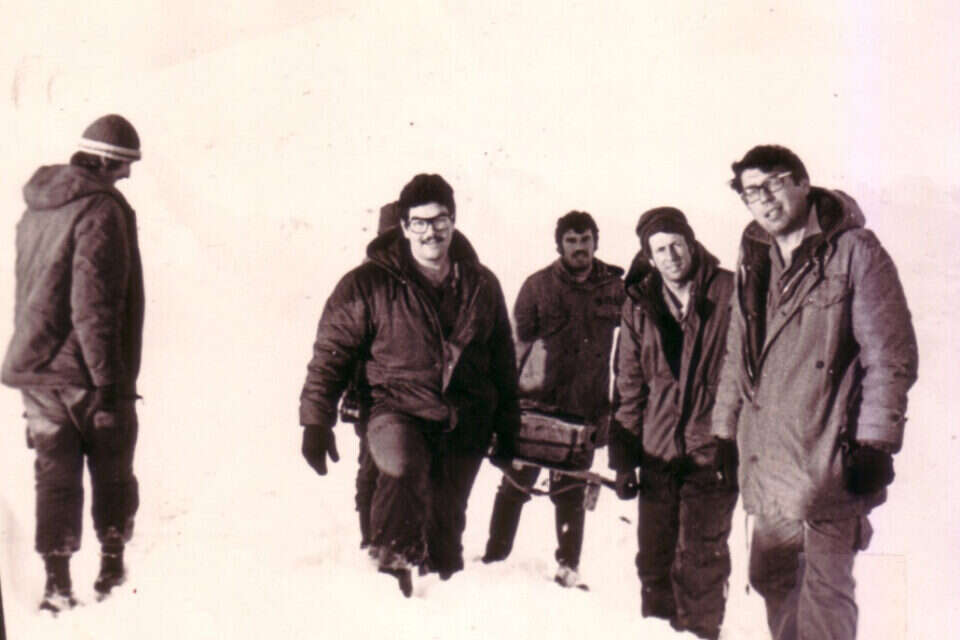Hagai Ben-Gurion, 82, from Beit HaShita, was one of the founders of the IDF's electronic warfare unit, which for many years was confidential and in which those who served in it were forbidden to reveal photographs from the Yom Kippur War - until five years ago the unit established a heritage room. Now, 50 years after the war, Hagai is happy to reveal for the first time photographs he took, which documented life at the Hermonit outpost during the war and in the months that followed.
The view from the Hermonit outpost in the winter after the Yom Kippur War, photo: Hagai Ben Gurion
For seven months, the soldiers remained at the post and did not go home on leave. The winter of 1973-4 was one of the hardest, a lot of snow covered the military vessels, and in parallel with the battles against the Syrians, the soldiers also fought General Winter. "Everything was buried under the snow and we couldn't operate the equipment," Ben-Gurion recalls. "Camouflage nets have become iron wires from the ice. It was heartbreaking."
Hagai the kibbutznik, who enlisted in the IDF in 1961, says that the purpose of the secret unit was "to disrupt and block wireless and radio broadcasts. The unit consisted of three engineers and three technicians, for a total of 15 people. We couldn't get help from anyone because of the secrecy. We weren't allowed to document anything. They asked us to find solutions, and for a year we thought. We should have thought 30 years ahead." A year after its establishment, the unit numbered 200 people, and during the Six-Day War it operated under a cloak of secrecy.
"I said to my wife: Tomorrow there is a war."
Two weeks before the Yom Kippur War, Hagai was drafted into the reserves, and teams were sent to Sinai and the Golan. On the eve of the war, the soldiers of the unit asked if it was possible to go home. "The answer we got was: Tomorrow at 18 p.m. there is a war, the officers will stay and the soldiers will leave for 00 hours. I got home, and when I told my wife that tomorrow there was a war, she fell off her feet. The next day, at 24:14 P.M., there was an alarm and I went back to the army."
Contact box whose entrance was blocked by snow, photo: Hagai Ben-Gurion
Soldiers of Unit 374, currently subordinate to the Spectrum Warfare Center, photo: Hagai Ben-Gurion
At first, the unit's soldiers showed up on Mount Canaan in Safed, seeing the slopes of the Golan Heights burning and hundreds of vehicles making their way to Ziv Hospital, with wounded from the fierce battles inside. A few days later, the electronic warfare teams were loaded to the Hermonit outpost on the slopes of Mount Hermon.
The IDF feared that the Syrians would try to kidnap the unit's soldiers during the winter, so they sent soldiers from a paratrooper patrol to guard them. They patrolled near the outpost, completely cut off, after the pillars marking the snow had been covered themselves, and a helicopter brought them supplies.
Haggai: "Winter came early and we weren't ready. Extreme winter, with minus ten degrees at night. We had nothing to wear this winter. The gas in the kitchen froze, everything froze around us. We went to the Syrian dugouts and took beds, mattresses and gas masks, and used them to warm our hands and feet. The war was facing winter."
A few days later, the soldiers were told that one of them could go home for 12 hours. "I said I was close and I would make it, and I left," Hagai remembers. "At home, I took the Zorkin 4 camera I had, four films, and went back to the post." Hagai began filming life at an outpost in the snow.
A big blow to the wing. The wreckage of one of the IAF's Phantom planes sent to assist units in the north and was mostly hit by Syrian surface-to-air missiles, photo: Hagai Ben-Gurion
They did not return safely. The 7th Reconnaissance APC that was damaged at the beginning of the war by an ambush by Syrian commandos near Kibbutz Elrom. 19 soldiers of the cruiser were killed in the encounter, Photo: Hagai Ben-Gurion
The last task
In March 1974, the snow at the post began to melt, and life returned to normal. The war with Syria was facing a ceasefire, both sides tried to establish facts on the ground before it went into effect, and a moment before that, Hagai and his comrades had to carry out one last, more mission.
Due to the fear that the Syrians would shell the soldiers of the Paratroopers Battalion, which was located in the Mazra'at Beit Jan enclave, the electronic warfare soldiers were required to disrupt the frequency of the Syrian artillery officer. Every time a frequency passed, they disrupted it, and so for a long time the Syrians were unable to shell the paratroopers, which allowed the IDF to respond accordingly. "I received a telegram from Unit 848 (today's Unit 8200; A) We acted well and prevented harm to the paratroopers. I felt a lot of pride," Hagai smiles.
The photographs Hagai took were developed after the war. "People wanted to be photographed all the time. We felt isolated," he says, adding proudly: "Only now, when the pictures appeared in the unit's heritage room, did the friends see them. It was an exciting and empowering time."
Wrong? We'll fix it! If you find a mistake in the article, please share with us

